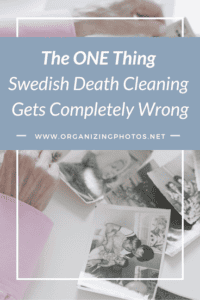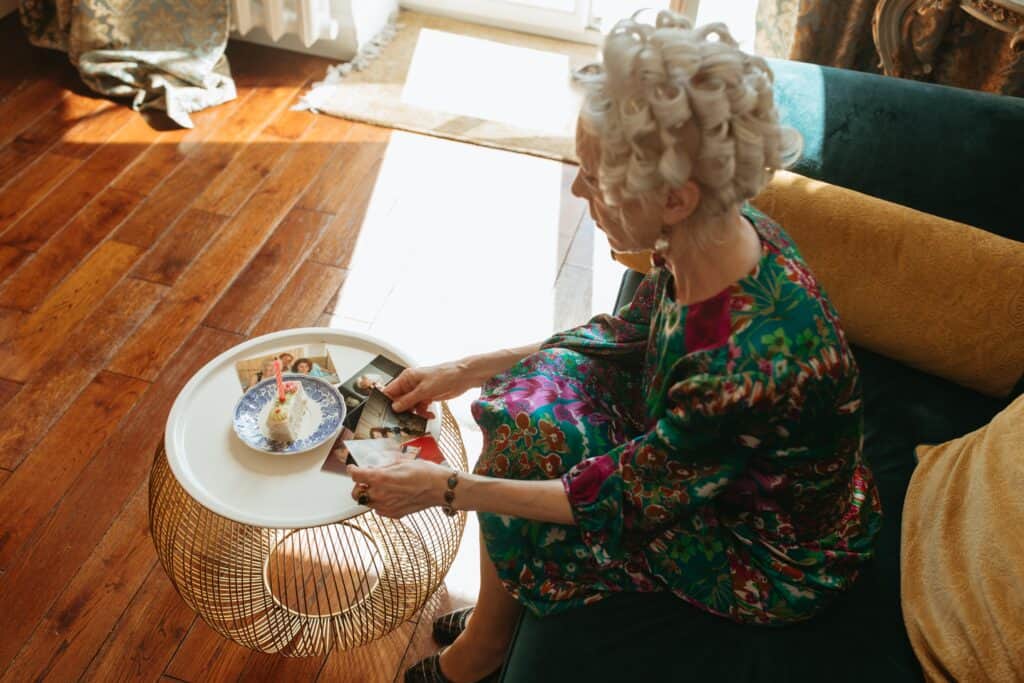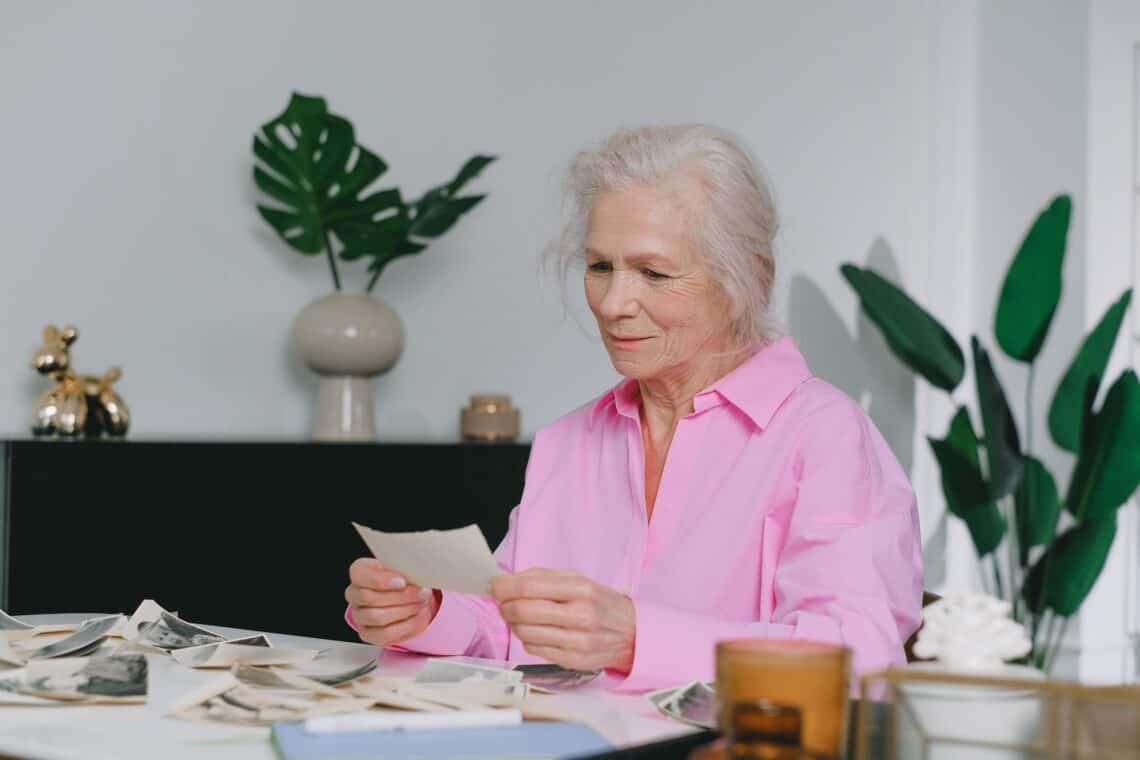You’ve probably heard of Swedish Death Cleaning, right? In Swedish, it’s known as “Döstädning.” In this article, we cover what it’s all about and how pertains to your memories and stories. Please note that the opinion stated within this article is mine, and mine alone. I am no one’s affiliate on this, I and have no ulterior motive. This is simply an opinion piece that I felt compelled to write due to the volume of questions I get on the topic. 😉
“As a Swede, How Do You Feel about Swedish Death Cleaning?”
Oh boy. If I had a nickel for every time I’ve heard that question in the last few years….
As someone who has been in the Organizing & Productivity business for over a decade, I get asked about Swedish Death Cleaning (and all that it entails) A LOT… After all, I am known as The Swedish Organizer, so I suppose it makes sense. Hence my urge to pen this article.
There are many benefits to Swedish Death Cleaning (Döstädning), but there’s one thing that really bothers me, so let’s talk about it, shall we? Read on, friend.
What Makes Me an Authority on Swedish Death Cleaning (Döstädning)?
Before I go into my spiel on the topic at hand, let me answer the question of why I feel compelled to share. Sure, I didn’t write the book on it, but I’m Swedish by birth and a Professional Organizer by trade, so I have a vested interest in understanding the methodology (journalists ask me about it all the time, for example). And I do.
I’ve given numerous presentations on Death Cleaning and the Swedish approach to organization and productivity in many professional settings. In fact, a colleague and I presented on this topic at the 2019 NAPO (National Association of Organizing and Productivity Professionals) Conference – with Margareta Magnusson’s blessing. Add to that, the fact that my own parents are currently in the process of death cleaning, and you’ll understand why I’m passionate about it. It’s all around me.
Swedish Common Sense is Naturally Baked into My Work
I grew up in Sweden, and though I currently live abroad, I still spend a significant amount of time there still (usually, several months every year). It’s where I got started, and my native culture has thoroughly influenced how and what I teach. You can take the girl out of Sweden, but you can’t take Sweden out of the girl. In fact, in many of my online courses, students often comment on how Swedish I sound when I talk about common-sense practical concepts.
Swedish Death Cleaning (Döstädning) is not a service I offer at the moment (I pivoted from residential organizing to digital organizing some years ago), but I have helped plenty of clients with it in the past, giving me extensive experience and insight on the subject, and in combination with my experience as a professional photo organizer, I feel more than qualified to comment. So with that as the backdrop, let’s go into this conversation.
What is Swedish Death Cleaning?
First, let’s define what Swedish Death Cleaning really is… In Sweden, we call it Döstädning, which is a literal translation. This concept pretty much sums up the Swedish collective attitude towards decluttering in one word. It promotes the vantage point that you declutter as you enter the last phase of your life, so as to not burden others with your “stuff” once you’re gone. In plain terms, you are going to die, and since you can’t take your things with you, you gotta figure out how to best sort everything out before that day comes.
Swedish Death Cleaning is Highly Cultural
It’s important to understand that Döstädning (Death Cleaning) is a very cultural concept. Just like Marie Kondo and her Japanese approach to organization (does it spark joy?), this practice is deeply rooted. You are not to bother others with your mess.
The Swedish culture is very direct, responsible, and considerate. Growing up there, you are taught to not inconvenience others – ever. This means being orderly, staying on top of your responsibilities, and doing what you can to not be a nuisance. If you make a mess, you clean it up. It’s that simple. Swedes are practical. We don’t like to beat around the bush, which, in turn, explains the origins of death cleaning. To truly understand Döstädning, you have to understand Swedish culture.
What Swedish Death Cleaning Gets Right
There are a lot of things that Swedish Death Cleaning gets right, and I’ll touch on just a few of those aspects before we continue to my frustration with it.
1. It Reduces Your Footprint
Let’s first start with the fact that, by adopting this approach, you are taking responsibility for your footprint while you are here on earth. Personal responsibility is a big thing in Sweden. Blaming others for your decisions is not. In a world where everyone likes to redirect blame, this is big. We are all responsible for our own decisions, and Death Cleaning / Döstädning gets that absolutely right.
2. Death Cleaning is a Practice
Secondly, Döstädning is a practice. Us Swedes understand that decluttering your entire life takes time, and that’s OK. This is not something to do on a Sunday afternoon between 2 and 3 PM. This is something you do on every Sunday afternoon for weeks, months, or even years. Finding the right home for your items is a loving process that needs to be sustainable, and it can only become sustainable if it is a practice and not a project. We trust the process and don’t rush through it.
3. Wealth and Knowledge Must Be Passed On
Third, Swedes view death cleaning as a redistribution of the wealth and knowledge that has been accumulated in the first half of life. We spend the first few decades of life trying to earn, learn, and distill as much as possible, and the final years of life trying to pass that on. Paying it forward is a big part of contributing to your community and your fellow citizens. #Correct.
4. Minimalism is Rooted in Practicality
Swedes tend to be fairly minimalistic to begin with, and when we invest in items, we go for quality over quantity. Everything should be not only stylish, but also functional, and ideally, last a lifetime. Disposable income is lower in Sweden than in many other European or North American countries, and besides, you don’t want to flaunt too much anyway. Contrary to commercialism, having too much stuff is not aspirational. Having the right stuff is.
5. Recycling is an Efficient Use of Resources
Once we have had enough use for an item, such as a piece of clothing, it’s most often donated rather than discarded. It’s considered ethical and trendy to shop second hand, and we have one of the more efficient second hand systems in the world. Entire malls, in fact. So passing on and passing things on is seen as process that goes hand-in-hand. Overall, it’s a healthy outlook, and a good use of our collective resources.

I’m a Perfect Pinnable!
What Swedish Death Cleaning Gets Wrong
As you can see, there are many benefits to Death Cleaning, most obviously the point that you get your affairs in order before your time is up. You take full responsibility for your earthly footprint yourself, which doesn’t leave things up to chance. It’s an aspiring approach that I believe everyone should take. The Swede in me appreciates its directness.
That being said, I disagree with the order in which things tend to happen.
According to Margareta Magnusson’s book “The Gentle Art of Swedish Death Cleaning” (In Swedish: Döstädning – Ingen Sorglig Historia), you are best off starting by decluttering what’s easiest in order to gain momentum, and then moving towards the more difficult items. Therefore, most people start by letting go of clothing, gadgets, and various knick knacks that have no sentimental value. While that is an understandable approach to take, I don’t believe it’s the correct one.
I have all the respect in the world for Margareta and her experience (as well as my culture and our traditions), but in my humble opinion, this order of operations is what death cleaning gets completely wrong.
Why I Disagree with the Methodology
I know this may be a controversial opinion, and I’m usually not one to criticize, but I feel very strongly about this, so I have to offer up my reasoning. I advocate for the process of Swedish Death Cleaning (Döstädning) as a whole, but through using a different methodology that prioritizes what actually matters in life – your memories.
Instead of doing the easy stuff first, I believe that you should start with the sentimental (a.k.a. more difficult) memories first. Why? Well, decluttering “stuff” is great, but if someone else had to do it for you, it wouldn’t be the end of the world. It would actually be quite an easy job to handle. I have several of very effective estate organizers as colleagues who could knock that out in a day or two without much trouble. Stuff is much easier to dispose of in comparison to memories because they don’t hold stories. Sure, you may have some heirlooms that hold stories (and we include those under the “memorabilia” umbrella), but not everything in your house are designated heirlooms. Most things are just that – things – and the don’t really matter.
Where Lies the True ROI on Döstädning?
When we talk about what to leave behind and what not to leave behind for the next generation, it seems wiser to spend the most time on curating your legacy. Your knick knacks go when you do, but your legacy? Well, that lasts for generations. It’s the one thing you do want to leave behind for others. Perhaps it’s my efficiency hat talking, but I’m interested in the longterm ROI on your efforts as you continue with your Death Cleaning (Döstädning) practice, and what’s the absolute best ROI you can get? Finishing your family archive.
I have previously written from my own experience about how meaningful your stories can be to those who come after you, and in my opinion, that’s where most of your earthly time should be spent. You have the ability to control how you are remembered, and how you contributed to your family tree, and that’s powerful. No one can tell that story but you. Your family archive shows who you were, what you were about, who you impacted, and what good you did while you were here. Isn’t that what truly matters?

In order to be truly effective, your death cleaning practice should begin with your stories, memories, and important photos. Not with knick knacks that don’t matter.
My Top 3 Reasons for Reversing the Methodology
Hopefully, you can see where I’m coming from in those few sentences above, but let me also elaborate most concretely on why you should reverse the methodology when death cleaning:
1. Your Can’t Outsource Stories
Yes, your photos and other memorabilia may be energetically heavier to deal with, but you have to tackle that collection first because it’s the the one thing that cannot be outsourced. At least, not well. Leaving behind a storied legacy is a gift to future generations, and that is much bigger in its purpose. Only you know your stories, and it’s your job to pass them on. If anything, that is the one thing that you DO want to pass on. Everything else – clothing, shoes, kitchen gadgets, furniture, knick knacks, etc. – can all be outsourced relatively easy when the day comes.
Can you outsource some stuff? Sure, you could hire me for that, but as a photo organizer, I can only do so much detective work. I may be able to figure out events, dates, and some names without you, but I don’t know the stories behind them. I don’t know why you went to on that cruise, took that trip to Tibet, or spent that year volunteering in Australia. I may be able to learn the name of your grandmother, but I can never explain what she meant to you. I work with second-hand information only, and that’s a loss because it’s in the first-hand information where the magic lives.
2. You’ll Eat Your Frog
We all know that motivation is hard to sustain, no matter the project. Often time, we are super excited in the beginning, and then that energy fades quickly when we realize how difficult things can get. That’s why I like to tackle harder things up front when my energy is higher. You may know this concept as “eating the frog.” It’s a productivity technique that promotes doing the hardest things first, so that you get them out of the way while you have the energy and the motivation to do so.
Waiting to tackle something difficult until the end of a process usually results in it not being finished. Your photos, stories, and memories are too important to leave unfinished, so tackling your family history first is key. Make sure it gets done right!
3. Your Memory Fades with Time
The longer you wait to tell your stories, the more your memory fades, and considering the fact that Death Cleaning a.k.a. Döstädning can take years, you want to capture those stories NOW, while you have the chance. In the off chance of an illness or accident (at any age, in fact), your stories are at risk, so you want to get to them as early as possible. With every turn around the sun, you get a little bit further away from the truth, so the sooner you act, the better. That way, it’s less overwhelming, and you’ll actually remember the details.
Your Legacy Is Everything
Whether you decide to participant in the process of death cleaning or not, I hope you take this article as inspiration to do something with your family memories. Take my advice and do it NOW, or at least, as early as possible. You’ll be glad you did.
If you decide to do it later, fine, but please make it a priority to finish the job. It’s never ideal to leave things behind for other generations to deal with, of course, but when it’s all said and done, the one thing you do want to leave behind is your family archive. Your legacy is everything. Do that bit first.
Need Further Help?
If you need some help, consider joining us in DPO PRO: The Ultimate Photo Organizing Masterclass. This is our best-selling photo organizing course that helps you sort out your family archive and get your memories back into your life.
If you’re a complete beginner, you may also want to check out our free webinar (video training) called The 3-Step Framework to Digital Photo Organizing Success. It’s available on demand for a limited time to new subscribers and contains a special offer on our class at the very end.
Got questions about any of our services or offers? Feel free to send us a note at hello@theswedishorganizer.com – even if we aren’t the right match for you, we probably know who is. Best of luck on your journey!
Featured Photo Courtesy of SHVETS Productions





Teri Winfield
May 29, 2023 at 2:57 pmVery respectfully written. And it makes so much sense. The photos and stories are far more valuable than my grandmother’s silver. I’ve been chipping away at a couple of photo/memorabilia projects of my own that no one else is privy to – yet. I plan to be around for decades, but . . . Thank you for validating my decision to do the hard work first. I inherited the photos of both grandmothers, my mother and my mother-in-law in addition to my own large collection. It’s gonna take a minute! Thank you for sharing your perspective.
Caroline Guntur
May 30, 2023 at 3:59 amThanks Teri! I believe firmly that we should focus on what we DO want to pass on. Once that’s out of the way, everything else is fair game.
Barbara Tien
May 31, 2023 at 12:56 pmBravo, Caroline. I really appreciate your notes about the cultural connection and comparing that to Marie Kondo’s approach. Subtle, but important.
As for your “do the hard things first,” approach, I totally agree. So often the “hard things” are pushed out, then lost as memories get clouded by age.
I’ve found that people often look at capturing their legacy as a hard challenge because it takes so much reflection to determine how they want to be remembered, or what was significant. This is especially hard for very modest people who may truly not appreciate what a difference they’ve made in the lives of others.
So, I’d flip that question around.
Instead of focusing on “your legacy,” think about what you uniquely experienced. It could be little moments and vignettes that you uniquely remember about others, or historical events. This is where photos come into play and why today’s means to digitize and capture are so important.
There are now so many ways to capture memories, stories, and legacy. From my perspective, with the support of talented professional organizers, genealogists, and family historians anyone can get started today sorting through the important stories first. They’re the ones that matter.
Caroline Guntur
May 31, 2023 at 4:38 pmGreat point, Barbara. I hope more people start to understand just how important they have been in other people’s lives.